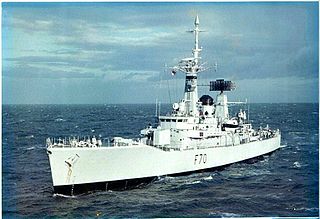
The Leander-class, or Type 12I (Improved) frigates, comprising twenty-six vessels, was among the most numerous and long-lived classes of frigate in the Royal Navy's modern history. The class was built in three batches between 1959 and 1973. It had an unusually high public profile, due to the popular BBC television drama series Warship. The Leander silhouette became synonymous with the Royal Navy through the 1960s until the 1980s.
Seven vessels of the British Royal Navy have been named HMS Bulldog, after the bulldog, with an eighth announced:
HMCS Fort Erie was a River-class frigate that served in the Royal Canadian Navy during the Second World War and as a Prestonian-class frigate from 1956-1965. She was named for Fort Erie, Ontario.

HMCS Penetang was a River-class frigate that served in the Royal Canadian Navy from 1944 to 1945 during the Second World War. She fought in the Battle of the Atlantic as a convoy escort. She was recommissioned and served as a Prestonian-class frigate from 1954 to 1956. She was named for Penetanguishene, Ontario.
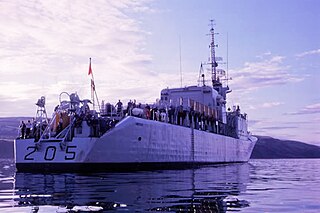
HMCS St. Laurent was a St. Laurent-class destroyer that served in the Royal Canadian Navy and later the Canadian Forces from 1955–1974. She was the lead ship of her class, the first modern warship designed and built in Canada.
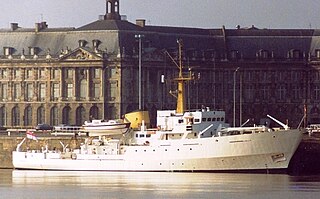
HMS Beagle was a Bulldog class coastal survey vessel of the Royal Navy and was the ninth to bear the name.
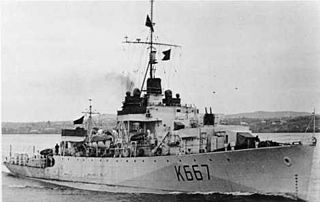
HMCS Inch Arran was a River-class frigate that served with the Royal Canadian Navy during the Second World War and again from 1954 to 1965, when she was converted into a Prestonian-class frigate. She was named after Inch Arran Point in Dalhousie, New Brunswick, Canada. This was due to the inability of two Allied warships to bear the same name. The RCN would then use landmarks or significant areas that were associated with the community instead.

HMCS Glace Bay was a River-class frigate built for the Royal Canadian Navy (RCN) in 1943. Commissioned in 1944 she served in the Battle of the Atlantic until the end of the Second World War. After the war, she was sold to the Chilean Navy and renamed Esmeralda.
HMCS Buckingham was a River-class frigate that served with the Royal Canadian Navy during the Second World War and as a Prestonian-class frigate from 1954–1965. She was named for Buckingham, Quebec. She is considered a significant part of Canadian naval history as used for some early trials of helicopter landings on smaller escort vessels. This led to the development of the future helicopter carrying destroyers.
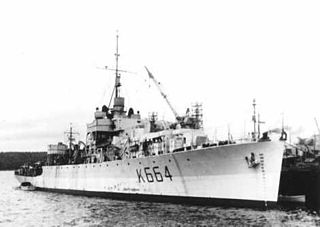
HMCS Carlplace was a River-class frigate that served with the Royal Canadian Navy during the Second World War. She served primarily as an ocean convoy escort in the Battle of the Atlantic. After the war, she was sold to the Dominican Republic and renamed Presidente Trujillo and in 1962, Mella.

HMCS Lanark was a River-class frigate that served with the Royal Canadian Navy during the Second World War and again from 1956–1965 as a Prestonian-class frigate. She fought primarily in the Battle of the Atlantic as a convoy escort. She was named for Lanark, Ontario.

HMCS Ste. Therese was a River-class frigate that served with the Royal Canadian Navy during the Second World War. She served primarily as a convoy escort in the Battle of the Atlantic. She was named for Sainte-Thérèse-de-Gaspé, Quebec. After the war she was converted to a Prestonian-class frigate and served until 1967.

HMCS Sussexvale was a River-class frigate that served with the Royal Canadian Navy during the Second World War. She served primarily as a convoy escort in the Battle of the Atlantic. She was named for Sussex, New Brunswick. Her name was altered to prevent confusion with other Allied warships named Sussex. After the war she was converted to a Prestonian-class frigate and served until 1966. She was the last frigate launched by the Royal Canadian Navy during the Second World War.
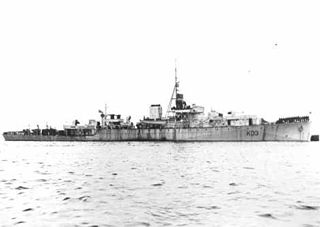
HMCS Dunver was a River-class frigate that served with the Royal Canadian Navy during the Second World War. She served primarily as a convoy escort in the Battle of the Atlantic. She was named for Verdun, Quebec. Her name was altered to prevent confusion with other Allied warships named Verdun.

HMCS Waskesiu was a River-class frigate of the Royal Canadian Navy. The frigate served as a convoy escort in the Battle of the Atlantic during the Second World War. It was the first frigate constructed and commissioned into the Royal Canadian Navy. Following the war, the vessel was sold to India where it was renamed Hooghly. Named after the town of Prince Albert, Saskatchewan, there was already a warship named "Prince Albert". The Royal Canadian Navy then named the ship after the town closest to Prince Albert National Park.
HMCS Noranda was a Canadian Bangor-class minesweeper built for the Royal Canadian Navy in 1940. She was launched on 13 June 1941 and escorted convoys for the rest of the war. After the war the minesweeper was refitted and was transferred to the Royal Canadian Mounted Police as Irvine. In 1962, the ship was sold and was turned into the yacht Miriana. Renamed Marijana and Viking L&R in 1969, the yacht sank in May 1971 off the coast of Jamaica.
HMCS Kelowna was a Bangor-class minesweeper constructed for the Royal Canadian Navy during the Second World War. Entering service in 1942, the minesweeper spent the entire war on the West Coast of Canada, mainly as a patrol vessel. Following the war, Kelowna was sold for mercantile conversion. Renamed Hung Hsin and Condor, the final disposition of the vessel is disputed.
HMCS Truro was a Bangor-class minesweeper that served with the Royal Canadian Navy during the Second World War. The minesweeper entered service in 1942 and took part in the Battle of the Atlantic and the Battle of the St. Lawrence. Following the war, the vessel was transferred to the Royal Canadian Mounted Police and renamed Herchmer. In 1946, Herchmer was sold for mercantile conversion and reappeared as Gulf Mariner. The ship was abandoned in 1964 on the Fraser River shore after plans for conversion to a suction dredger failed. The abandoned hulk was broken up.
HMCS Trois Rivières, alternatively spelled Trois-Rivieres and Trois-Rivières, was a Bangor-class minesweeper that served with the Royal Canadian Navy during the Second World War. The ship entered service in 1942 and served as a patrol and convoy escort vessel in the Battle of the Atlantic. Following the war, the minesweeper was transferred to the Royal Canadian Mounted Police and renamed MacBrien. The vessel was sold for scrap and broken up in 1960.












